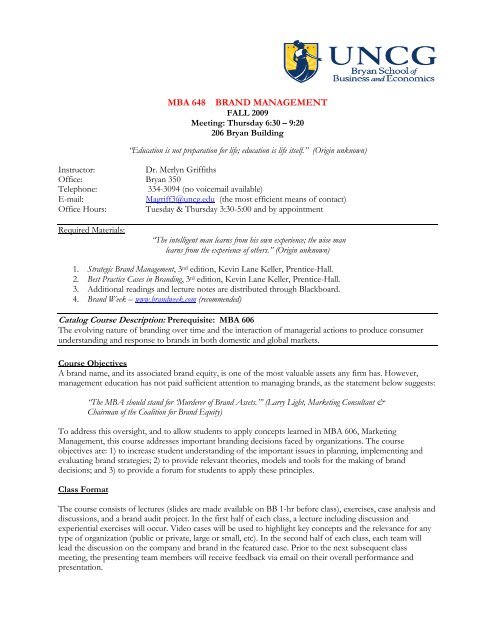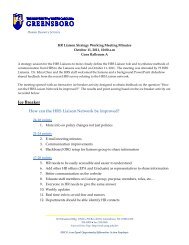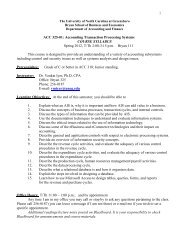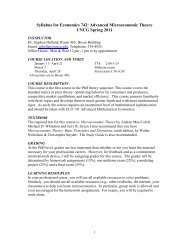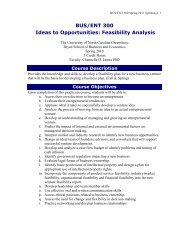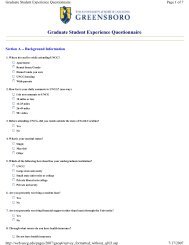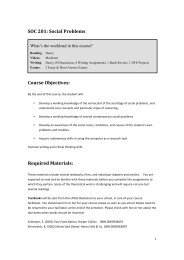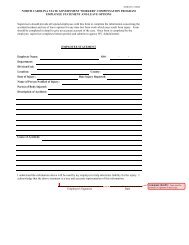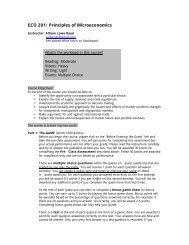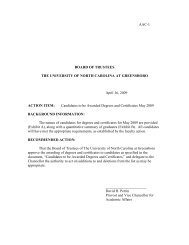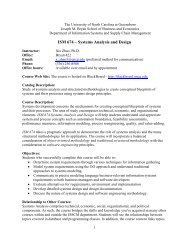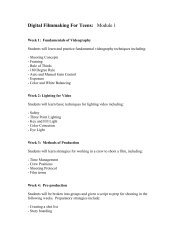STRATEGIC BRAND MANAGEMENT
STRATEGIC BRAND MANAGEMENT
STRATEGIC BRAND MANAGEMENT
Create successful ePaper yourself
Turn your PDF publications into a flip-book with our unique Google optimized e-Paper software.
MBA 648 <strong>BRAND</strong> <strong>MANAGEMENT</strong><br />
FALL 2009<br />
Meeting: Thursday 6:30 – 9:20<br />
206 Bryan Building<br />
“Education is not preparation for life; education is life itself.” (Origin unknown)<br />
Instructor:<br />
Dr. Merlyn Griffiths<br />
Office: Bryan 350<br />
Telephone:<br />
334-3094 (no voicemail available)<br />
E-mail:<br />
Magriff3@uncg.edu (the most efficient means of contact)<br />
Office Hours: Tuesday & Thursday 3:30-5:00 and by appointment<br />
Required Materials:<br />
“The intelligent man learns from his own experience; the wise man<br />
learns from the experience of others.” (Origin unknown)<br />
1. Strategic Brand Management, 3 nd edition, Kevin Lane Keller, Prentice-Hall.<br />
2. Best Practice Cases in Branding, 3 rd edition, Kevin Lane Keller, Prentice-Hall.<br />
3. Additional readings and lecture notes are distributed through Blackboard.<br />
4. Brand Week – www.brandweek.com (recommended)<br />
Catalog Course Description: Prerequisite: MBA 606<br />
The evolving nature of branding over time and the interaction of managerial actions to produce consumer<br />
understanding and response to brands in both domestic and global markets.<br />
Course Objectives<br />
A brand name, and its associated brand equity, is one of the most valuable assets any firm has. However,<br />
management education has not paid sufficient attention to managing brands, as the statement below suggests:<br />
“The MBA should stand for „Murderer of Brand Assets.‟” (Larry Light, Marketing Consultant &<br />
Chairman of the Coalition for Brand Equity)<br />
To address this oversight, and to allow students to apply concepts learned in MBA 606, Marketing<br />
Management, this course addresses important branding decisions faced by organizations. The course<br />
objectives are: 1) to increase student understanding of the important issues in planning, implementing and<br />
evaluating brand strategies; 2) to provide relevant theories, models and tools for the making of brand<br />
decisions; and 3) to provide a forum for students to apply these principles.<br />
Class Format<br />
The course consists of lectures (slides are made available on BB 1-hr before class), exercises, case analysis and<br />
discussions, and a brand audit project. In the first half of each class, a lecture including discussion and<br />
experiential exercises will occur. Video cases will be used to highlight key concepts and the relevance for any<br />
type of organization (public or private, large or small, etc). In the second half of each class, each team will<br />
lead the discussion on the company and brand in the featured case. Prior to the next subsequent class<br />
meeting, the presenting team members will receive feedback via email on their overall performance and<br />
presentation.
Course Requirements and Evaluation<br />
In-class participation and performance 20%<br />
Individual Case Analysis 30%<br />
Weekly Group Case Lead* 20%<br />
Brand Audit Group Project* 30%<br />
A 94-100<br />
A- 90-93<br />
B+ 87-89<br />
B 83-86<br />
B- 80-82<br />
Grading Scale<br />
C+ 78-79<br />
C 73-77<br />
C- 70-72<br />
D 60-69<br />
F Below 60<br />
* 50% of the individual‟s grade will be determined by your team member‟s evaluation of your performance<br />
and contribution toward the successful completion of the assignment.<br />
Note: There are no exams in this course. It will be up to students to learn the brand strategy concepts and<br />
terminologies explained in lectures, readings and articles and to accurately and persuasively apply them in the<br />
case analysis, group case presentation and brand audit project.<br />
****All written assignments should be turned in at the beginning of the class on the due date. Late<br />
submissions will not be accepted.<br />
Note: Grades are non-negotiable and final grades can only be changed to correct calculation or input<br />
errors on my part. If you have questions as to the validity of a grade this must be brought to my attention in<br />
writing within one (1) week of the day/date the grade is posted.<br />
Grades WILL NOT be determined by a standard bell curve whereby the majority of the class receives a „C‟<br />
and the minority receives otherwise. Rather, grades will strictly depend on the number of points accumulated<br />
relative to the total number of points allotted in the course.<br />
**Note: All submitted work can be easily checked for plagiarism. To avoid discrepancies, be sure to cite appropriately works of<br />
others that you are referencing. Use APA style. See blackboard for a detailed document on the proper format for citations. For<br />
details on what constitutes plagiarism, please visit http://academicintegrity.uncg.edu/<br />
Class Participation (20%)<br />
“If you think you‟re too small to be effective, you have never been in bed with a mosquito.” (Bette Reese)<br />
Current Events: Scanning the environment, you will soon identify changes in current marketplace<br />
conditions. Each week (sessions 1-6) you can choose to present an article, ad, news release, etc from any<br />
current publication or credible internet source. The topic should coincide with the topics for the class period.<br />
These discussions will increase your knowledge and fuel your thoughts as you complete the analysis for the<br />
Brand Audit project.. Turn in a copy of the item with a short summary of the issue/relevance.<br />
Active student participation is essential to the learning process and to the success of the course. Attendance in<br />
class is required at all times. Students are expected to be fully prepared to discuss reading assignments.<br />
Participation points will be given based on constructive participation in class discussions and in-class<br />
exercises.<br />
Below is a description of how your class contributions will be calibrated. As you will see, the emphasis is not<br />
on the amount of airtime one has, but the quality of the content offered:<br />
Outstanding Contributor: Contributions in class reflect exceptional preparation. Ideas offered are always<br />
substantive, and provide one or more major insights as well as providing a fruitful direction for the class.<br />
Arguments are well substantiated and persuasively presented. If this person were not a member of the class,<br />
the quality of the discussions would be diminished significantly.<br />
2
Good Contributor: Contributions in class reflect thorough preparation. Ideas offered are usually substantive;<br />
provide good insights and sometimes a fruitful direction for class discussion. Arguments, when presented,<br />
are generally well substantiated and are often persuasive. If this person were not a member of the class, the<br />
quality of discussions would be diminished considerably.<br />
Satisfactory Contributor: Contributions in class reflect adequate preparation. Ideas offered are sometimes<br />
substantive, provide generally useful insights, but seldom offer a major new direction for the class.<br />
Arguments are sometimes presented, and are fairly well substantiated and sometimes persuasive. If this<br />
person were not a member of the class, the quality of discussions would be diminished somewhat.<br />
Unsatisfactory Contributor: Contributions in class reflect inadequate preparation. Ideas offered are seldom<br />
substantive, provide few useful insights, and rarely offer a constructive direction for the class. Class<br />
contributions are few and far between. Many contributions are “cherry picking” efforts making isolated,<br />
obvious or confusing points. If this person were not a member of the class, the quality of discussions would<br />
not be changed or perhaps even improved.<br />
Individual Case Analysis: (30%)<br />
Each student will select one case from the following list and create a written analysis. THIS IS NOT A<br />
GROUP ASSIGNMENT. The analysis must be typed, 12 point font, 1-inch margins, double spaced, 12<br />
page maximum (not including appendices and exhibits). Completed case analysis (hard copy only) is<br />
due week 4, September 17 th .<br />
Select one of the following cases:<br />
1. General Electric: Branding in Business-to-Business<br />
2. Dupont: Managing a Corporate Brand<br />
3. Yahoo!: Managing an Online Brand<br />
General case write-up guidelines: Provide a coherent, well-organized analysis, not simply a list of<br />
arguments for or against a position. Be concise and do not spend time rehashing or paraphrasing the details<br />
of the case. Focus on the specific issues raised in the discussion questions and be as direct as you can in your<br />
answers. Grammatical errors, typos and poorly organized thoughts take away from the quality and credibility<br />
of your work and will negatively affect your grade. See case analysis document on blackboard for extensive<br />
guidance on how to prepare an analysis. *Pay close attention to all exhibits in the case.<br />
Analysis Format<br />
Use headings and subheadings<br />
Begin your written analysis with:<br />
Team Projects<br />
1. Brief overview of the company‟s key issue. (This should be no more than 1-page.)<br />
2. Identify and briefly describe the competitor brands in the marketplace. (This may require<br />
you to go outside of the case).<br />
3. Answer each question at the end of the case. Some questions have multiple parts – be sure<br />
to address each part.<br />
A total of 5 teams will be formed and announced before the first class meeting (see assignments at the end of<br />
this document). Some teams may have a member added/dropped following the add/drops for the class. It<br />
may become necessary to shift one or two individuals to balance out a team. Each team will be responsible<br />
for a group-lead case discussion and completing a brand audit.<br />
3
*Every effort will be made to allow for your group to meet in the last 20 minutes of each class, with<br />
the exception of session 7. If there are questions regarding the project, come see me early. Don‟t wait until<br />
the last week when it‟s too late to seek help.<br />
Group-Lead Case Discussion (20%)<br />
Each team will be responsible for leading the case discussion in one class session. You may use PowerPoint,<br />
however, it is strongly suggested that you keep these slides to a maximum of 20. At the beginning, give a<br />
VERY BRIEF overview of the case (1-2 slides). You are expected to engage the class in a discussion of the<br />
key issues involved. This includes addressing the questions at the end of the case. You are not limited by just<br />
the case content. You are expected to add new information, examples, comparisons, competitor information,<br />
recent trends, video, product/package samples, etc., to bring the case to life in a current day context. Be sure<br />
to apply the relevant course concepts, frameworks and theories in your discussion. *Pay close attention to<br />
all exhibits in the case.<br />
Brand Audit Project (30%)<br />
An essential ingredient of the course is the brand audit project. The idea behind the brand audit is for you to<br />
conduct an in-depth examination of a major brand of your choosing. Every team must study a different<br />
brand, and brands are assigned on a “first come, first serve” basis. The goal of the brand audit is to assess its<br />
sources of brand equity and suggest ways to improve and leverage that brand equity. Your brand selection<br />
and rationale for selection must be submitted to me via email by Monday, September 7 th . I will confirm via<br />
email to all team members if the brand is appropriate and whether or not the brand is available.<br />
Where to find brands:<br />
You can pick a brand you are familiar with or from the list of BrandZ‟s Top 100 Global Brands 2009, or the<br />
Interband & Business Week‟s Top 100 Brands. Here is a link to the Interband report summarizing the Top<br />
100 brands.<br />
http://www.interbrand.com/images/BGB_reports/BGB_2008_US_Format.pdf<br />
Companies and brands from Keller’s Best Practice Cases in Branding text cannot be selected for the<br />
brand audit.<br />
Project Details:<br />
The brand audit will be based entirely on information from public secondary sources, company web sites, as<br />
well as your own professional experiences and insights. I do not necessarily expect you to conduct any<br />
surveys or primary research. Specifically, you will assess brand planning, building, and growth of your chosen<br />
brand. Addressing these questions as you examine your brand will allow you to do this.<br />
Brand Planning<br />
The first element of a brand audit is a full description of the firm‟s current branding programs. This involves<br />
an analysis of the firm‟s brand hierarchy, brand portfolio, strategic branding alliances, the brand‟s current<br />
positioning in the marketplace, and how the firm is addressing branding through each of the marketing mix<br />
elements. Be sure to include brand elements (names, URLs, logos, symbols, characters, slogans, jingles,<br />
packaging).<br />
Address the following:<br />
a. How would you characterize the positioning of your brand<br />
b. Where are there the greatest opportunities to further enhance that positioning<br />
4
Brand Building Assessment<br />
The second element involves assessing brand building capabilities. Address the following questions:<br />
a. How much brand resonance does your brand have<br />
b. What have been the key marketing activities that have most contributed to the success of<br />
achieving its resonance and positioning<br />
c. How would you suggest that they improve on their brand building activities<br />
Brand Growth Assessment<br />
The third element involves assessing growth potential and providing recommendations. Address the<br />
following questions:<br />
a. How would you critique your brand‟s architecture<br />
b. What is good and bad about its hierarchy<br />
c. How does it fit into a broader brand portfolio<br />
d. How well has it been expanded into new markets or channels<br />
e. How would you judge its growth strategy<br />
Final Report and Presentation<br />
Use headings and subheadings throughout your report.<br />
The final report profiles the positioning of the brand, its sources of brand equity and provides<br />
recommendations concerning how to build and manage equity for the brand chosen. After summarizing<br />
current and desired brand knowledge structures, you should outline creative and relevant directions for<br />
management of your chosen brand, providing justification where appropriate with course concepts.<br />
The final written report should not exceed 20-typewritten pages in length (not including figures, references,<br />
or other supporting documentation), double-spaced, 1-inch margin pages, 12-point font.<br />
Presentation<br />
Your presentation should be a top-line summary of the key points from your report.<br />
Each team will have 30 minutes (25 min to present, 5 min Q&A). Every member of the team must<br />
present. The audience will evaluate each presentation.<br />
The final written report is due at this time. A copy of your PPT overheads must be attached (2 slides per<br />
page).<br />
Suggested web sites worth reviewing:<br />
BrandChannel (by Interbrand): brandchannel.com<br />
BrandForward: brandforward.com<br />
McKinsey & Company (McKinsey Quarterly): mckinseyquarterly.com<br />
Prophet Strategy: prophet.com<br />
BuildingBrands: buildingbrands.com<br />
Brand Keys Research: brandkeys.com<br />
Upshaw Brand Consulting site: brandbuilding.com<br />
Brand Republic: brandrepublic.com<br />
5
MBA 648 Brand Management Introduction Talk Sheet<br />
Please complete for first class meeting, print and bring to the first class<br />
This sheet will be collected<br />
Name: ____________________________________________________________________<br />
1) Current Employment ______________________________________________________<br />
2) Undergrad major: _________________________________________________________<br />
3) Years work experience: _____________________________<br />
4) List any other marketing classes you’ve had (include undergrad ):<br />
______________________________________________________________________________<br />
5) Rate your level of expertise with marketing (Circle one):<br />
1 2 3 4 5 6 7 8 9 10<br />
Marketing is too<br />
squishy for me<br />
I can list the 4Ps<br />
of marketing<br />
I can explain terms like<br />
positioning, PLC &<br />
competitive landscaping<br />
P&G calls<br />
me for<br />
advice<br />
* Your answers to 6, 7, 8, and 9 will be read aloud<br />
6) I think the best Brand is:______________________________________________________<br />
7) I think the worst Brand is : ____________________________________________________<br />
8) My favorite Brand is _________________________________________________________<br />
9) My favorite Brand tagline, slogan or character is ___________________________________<br />
______________________________________________________________________________<br />
10) What do you expect from this class<br />
______________________________________________________________________________<br />
______________________________________________________________________________<br />
7
Brand Management<br />
Class Schedule<br />
Fall 2009<br />
* All chapter readings are from Keller‟s Strategic Brand Management (SBM)<br />
* All cases are from Keller‟s Best Practice Cases in Branding (BPC). Pay close attention to the case exhibits.<br />
* Articles are posted on blackboard<br />
Preparation for Session 1:<br />
Reading:<br />
Course Syllabus<br />
SBM~ Chapter 1<br />
Article: BrandZ Best Global Brands 2009<br />
Assignment: 1) Complete the information sheet on page 7 of this document. Print & turn in at session 1<br />
2) Select a brand from BrandZ Best Global Brands, or Interbrand Top 100 Brands (see link<br />
on p.4), or other personal favorite. Be prepared to discuss: What is your favorite brand<br />
Why What makes it an outstanding brand<br />
Session 1: Thursday, August 27 th Brands and Strategic Brand Management<br />
Reading: SBM~ Chapter 1<br />
Article: The Brand Report Card by Keller<br />
Assignment:<br />
In Class:<br />
Assess your brand:<br />
(1) Rate and critically evaluate your favorite brand using The Brand Report Card criteria.<br />
(a)What strengths can it leverage (b)What weaknesses should it address<br />
(2) Is the brand strongly positioned versus the competition or vulnerable Why<br />
(3) Why do brands matter<br />
Introduction to the course<br />
Introduction to Brands<br />
Brief syllabus overview and Brand Audit project<br />
Session 2: Thursday, September 3 rd Building a Strong Brand<br />
Reading: SBM~ Chapter 2 and Brand Focus 2.0 (pp. 88-91)<br />
SBM~ Chapter 3<br />
BPC~ Case: “Dockers: Creating a Sub-Brand,” (Discussion questions, p. 219)<br />
In Class: Lecture 2<br />
Group 1: Lead discussion of Dockers case<br />
Brand Selection and Rationale due via email by September 7 th<br />
8
Session 3: Thursday, September 10 th Building Brand Equity<br />
Reading: SBM~ Chapter 4<br />
SBM~ Chapter 5 skim only<br />
BPC~ Case: “Red Bull: Building Brand Equity in Non-Traditional Ways,” (Discussion<br />
questions, pp. 91-92)<br />
In Class: Lecture 3<br />
Group 2: Lead discussion of Red Bull case<br />
Session 4: Thursday, September 17 th Brand Metrics and Value<br />
Reading: SBM~ Chapter 8 (pp 315-352)<br />
SBM~ Chapter 9 skim only<br />
BPC~ Case: “MTV: Building Brand Resonance,” (Discussion questions, pp. 115-116)<br />
Assignment:<br />
Individual Case Analysis due today (hard copy only)<br />
In Class: Lecture 4<br />
Group 3: Lead discussion of MTV case<br />
Session 5 Thursday, September 24 th Brand Integration<br />
Reading: SBM~ Chapter 6<br />
BPC~ Case: “Got Milk Branding a Commodity” (Discussion questions, p. 48)<br />
In Class:<br />
Guest Speaker: Mr. Gary Fly, Aha Water Company (tentative)<br />
Lecture 5<br />
Group 4: Lead discussion of Got Milk case<br />
Session 6: Thursday, October 1 st Brand Growth<br />
Reading: SBM~ Chapter 11<br />
SBM~ Chapter 13<br />
BPC~ Case: “Snapple: Revitalizing A Brand” (Discussion questions, p. 345)<br />
In Class: Lecture 6<br />
Group 5: Lead discussion of Snapple Case<br />
Session 7: Thursday, October 8 th Brand Audit Presentations<br />
In Class:<br />
Brand audit report with copy of PPT slides is due today (hard copy only)<br />
Brand audit presentations, 30 minutes per team<br />
Peer evaluations must be turned in (hard copy only).<br />
Audience evaluation of each presentation<br />
9
Brand Management<br />
Team Assignment<br />
Fall 2009<br />
Group 1 Group 2 Group3 Group 4 Group 5<br />
Johnson, Darek<br />
Maness, Brian<br />
Shah, Rutvee<br />
Tai, Chih-Wei<br />
Bryant, Krystle<br />
Kim, Eunah<br />
Moody, Rachel<br />
Nguyen, Toan<br />
Smith, Patrick<br />
Ahmad, Danyal<br />
Copeland, Raedene<br />
Kuo, CHIA-YU<br />
Moten, Margaret<br />
Sreekumar, Divya<br />
Dvoskin, Alan<br />
Lu, Pei Yu<br />
Sato, Miki<br />
Wang, Jou-Ya<br />
Williams, Susan<br />
Hall, Jaime<br />
Ma, Su-Ting<br />
Perfus, Sophie<br />
Padmanabhan, Parvathi<br />
Tsai, Pi-Wei


